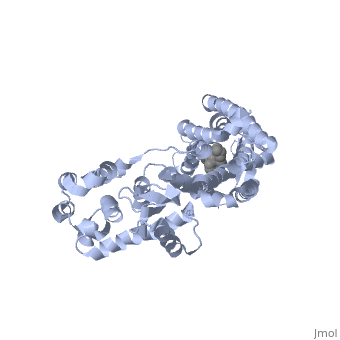Delta opioid receptor
From Proteopedia
(Difference between revisions)
| Line 1: | Line 1: | ||
==Background Information== | ==Background Information== | ||
| - | <StructureSection load='4ej4' size='340' side='right' caption='Cartoon representation of Delta opioid receptor bound to ligand in ball and stick representation.' scene=''> | + | <StructureSection load='4ej4' size='340' side='right' caption='Cartoon representation of Delta opioid receptor bound to ligand in ball and stick representation (PDB code [[4ej4]]).' scene=''> |
An opioid receptor is a membrane protein that acts as a receptor for endogenous neuropeptides called opioids. This receptor is an inhibitory G-protein coupled receptor that activates the parasympathetic nervous system in decreasing pain perception, slowing respiratory rate, improving mood, slowing digestion, and having an all-around analgesic effect on the body. Additionally, many agonists for this receptor are used as therapeutic drugs as powerful painkillers such as <scene name='71/715422/Morphine/2'>morphine</scene>, Percocet, and Vicodin. Some of these are naturally derived specifically from the poppy plant, and some are synthetically manufactured. There are three distinct opioid receptors, and the delta opioid receptor is one primarily responsible for the analgesic effects of opioids <ref>doi: 10.1097/ALN.0b013e318238bba6</ref>. | An opioid receptor is a membrane protein that acts as a receptor for endogenous neuropeptides called opioids. This receptor is an inhibitory G-protein coupled receptor that activates the parasympathetic nervous system in decreasing pain perception, slowing respiratory rate, improving mood, slowing digestion, and having an all-around analgesic effect on the body. Additionally, many agonists for this receptor are used as therapeutic drugs as powerful painkillers such as <scene name='71/715422/Morphine/2'>morphine</scene>, Percocet, and Vicodin. Some of these are naturally derived specifically from the poppy plant, and some are synthetically manufactured. There are three distinct opioid receptors, and the delta opioid receptor is one primarily responsible for the analgesic effects of opioids <ref>doi: 10.1097/ALN.0b013e318238bba6</ref>. | ||
Current revision
Background Information
| |||||||||||
References
- ↑ Al-Hasani R, Bruchas MR. Molecular mechanisms of opioid receptor-dependent signaling and behavior. Anesthesiology. 2011 Dec;115(6):1363-81. doi: 10.1097/ALN.0b013e318238bba6. PMID:22020140 doi:http://dx.doi.org/10.1097/ALN.0b013e318238bba6
- ↑ Granier S, Manglik A, Kruse AC, Kobilka TS, Thian FS, Weis WI, Kobilka BK. Structure of the delta-opioid receptor bound to naltrindole. Nature. 2012 May 16;485(7398):400-4. doi: 10.1038/nature11111. PMID:22596164 doi:10.1038/nature11111
- ↑ Granier S, Manglik A, Kruse AC, Kobilka TS, Thian FS, Weis WI, Kobilka BK. Structure of the delta-opioid receptor bound to naltrindole. Nature. 2012 May 16;485(7398):400-4. doi: 10.1038/nature11111. PMID:22596164 doi:10.1038/nature11111
- ↑ Granier S, Manglik A, Kruse AC, Kobilka TS, Thian FS, Weis WI, Kobilka BK. Structure of the delta-opioid receptor bound to naltrindole. Nature. 2012 May 16;485(7398):400-4. doi: 10.1038/nature11111. PMID:22596164 doi:10.1038/nature11111

